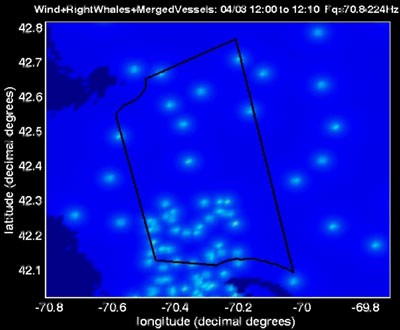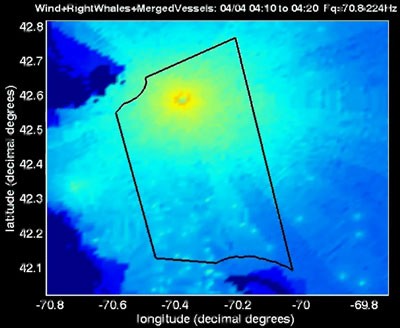Acoustic maps of ocean noise reveal how shipping traffic affects whales
By Krishna Ramanujan
Land areas are not the only places getting busier: so too are the oceans, says a Cornell researcher who uses underwater recorders to create animated maps of the oceans' noise.
Increasingly, the oceans are being polluted by shipping traffic noise, especially up and down the U.S. eastern and western seaboards. The cacophony interferes with the ability of whales and other sea animals to hear each other; they rely on quiet waters to communicate many miles apart.
"People have no idea the world in the ocean off the coast is so urbanized," said Christopher Clark, the I.P. Johnson Director of the Bioacoustics Research Program at the Cornell Lab of Ornithology, who discussed his state-of-the-art acoustic animations and the difficulties facing whales Feb. 21 at the American Association for the Advancement of Science (AAAS) annual meeting in San Diego.
His research not only documents ocean noise and its repercussions but also tracks such endangered species as the North Atlantic right whale.
Clark presented color animations that show time-elapsed maps of the sounds of passing whales and ships. Clark and colleagues placed arrays of recording devices spaced over the ocean floor for three months at a time. The devices were then retrieved, their terabytes of data analyzed at Cornell and transferred into a visual format.
"Now I can quantify how much [sound is generated] every time a ship comes through," Clark said. "It creates acoustic 'bleaching,' and you can measure how much acoustic space is lost by ships coming through. For example, every day right whales lose 80 to 85 percent of their opportunities to communicate as a result of ship traffic."
Sound travels very efficiently in water and gets trapped in a layer of water known as a deep sound channel about half a mile deep, depending on latitude, Clark said. He likened diving into this channel to a curtain rising so that suddenly you can hear clearer and louder. He hypothesizes that whales' voices and hearing have evolved to communicate with each other over very large distances.
"I can hear a blue whale that's singing off the Grand Banks of Canada while listening off Puerto Rico," Clark said.
Although blue whales use very low frequencies that can travel such great distances, higher-pitched humpback whale singers can be heard only over a few hundred miles, and North Atlantic right whales over only tens of miles.
But manmade sounds are now bleaching whales' underwater communication channels.
"Now we are listening to observe what the whales do as noise levels go up," Clark said.
Some 60 years ago when there was little traffic noise, whales could hear each other pretty much all the time, except when storms came through. Then they would stop chattering, only to resume when the storm passed.
But now, what do whales do amid the steady din? Using his acoustic techniques, Clark has found that as traffic noise increases or oil exploration vessels pound the sea floor, communication among whales breaks down, and sometimes the animals evacuate the area within hours to days.
Clark also discussed the use of listening buoys off the coast of Massachusetts that automatically detect right whales and inform ship captains to slow down when a whale is in or near the shipping lanes.
Get Cornell news delivered right to your inbox.
Subscribe
